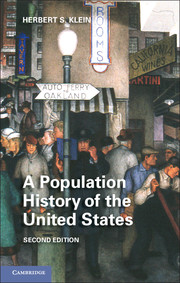Book contents
- Frontmatter
- Contents
- Graphs, Maps, and Tables
- Introduction to the Second Edition
- Introduction to the First Edition
- 1 Paleo–Indians, Europeans, and the Settlement of America
- 2 Colonization and Settlement of North America
- 3 The Early Republic to 1860
- 4 The Creation of an Industrial and Urban Society, 1860–1914
- 5 The Evolution of a Modern Population, 1914–1945
- 6 The Baby Boom and Bust and the New New Immigrants, 1945–1970
- 7 An Advanced Industrial Society, 1970–2011
- Appendix Tables, Graphs, and Maps
- Bibliography
- Index
Introduction to the Second Edition
Published online by Cambridge University Press: 05 June 2012
- Frontmatter
- Contents
- Graphs, Maps, and Tables
- Introduction to the Second Edition
- Introduction to the First Edition
- 1 Paleo–Indians, Europeans, and the Settlement of America
- 2 Colonization and Settlement of North America
- 3 The Early Republic to 1860
- 4 The Creation of an Industrial and Urban Society, 1860–1914
- 5 The Evolution of a Modern Population, 1914–1945
- 6 The Baby Boom and Bust and the New New Immigrants, 1945–1970
- 7 An Advanced Industrial Society, 1970–2011
- Appendix Tables, Graphs, and Maps
- Bibliography
- Index
Summary
Given the seven years that have passed since the last revision of this text, my own thinking has changed about the chronology applied to the demographic history of the 20th century. It is now evident that the decade of the 1960s for the United States, as well as for most of the world, was a profound marker of change. The sudden decline in fertility that occurred in the decade of the 1960s was considered at the time to be a temporary phenomenon. But it is now evident from all the advanced industrial societies that this new low-low fertility, as the demographers are calling this change, is a permanent part of the posttransitional model of demographic change for all advanced industrial societies. All the major industrial states are now at or below replacement fertility, and most of the developed world is quickly following their lead. The second factor marking the decade of the 1960s as important was the change in immigration laws in the United States, which again opened up the country to a new era of international migration in the following decades, which in turn led to Hispanics emerging as the largest minority in the country. Thus, I have confined the postwar chapter to the period 1945–1970 and have used the 1970 census as a terminal point, with some suggestions of how changes which began in the late 1960s saw their full development in the 1970s.
- Type
- Chapter
- Information
- A Population History of the United States , pp. 1 - 2Publisher: Cambridge University PressPrint publication year: 2012



